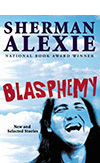book
Blasphemy: New and Selected Stories
by Sherman Alexie ’94 :: Grove Press :: Reviewed by John Streamas

Most writers’ volumes of “new and selected” stories add only two or three new pieces to twenty or thirty old ones. More than half of Sherman Alexie’s Blasphemy is new, however, including a few lengthy stories. The success of Alexie’s teen novel The Absolutely True Diary of a Part-Time Indian seems to have invigorated his short stories, and readers who regard them as his best work will be delighted by this new book. To be sure, this is not for very young readers, though the reason is not the occasional sexual reference but the grimness of many characters’ struggles to live. Alexie seems to say that the survival of his community has cost the deaths of too many of its people.
And yet this is not a grim book. It is very funny, sometimes raucously. In the new story “Cry Cry Cry,” young Native “fake gangsters” go “drive-by cursing” and throw government food at each other. The narrator of “Salt” describes the editor of a newspaper as “a bucket of pizza and beer tied to a broomstick.” A character in “This Is What It Means To Say Phoenix, Arizona” tells a story of two Indian boys who want to be warriors but who, lacking horses, park a car they have stolen in front of a police station and walk home to the reservation.
Alexie is indigenous literature’s version of Dave Chappelle and Richard Pryor, reasoning that illness and poverty and death may as well provoke laughter along with tears. Some of the funniest moments occur in the saddest stories. “War Dances,” the title story in Alexie’s previous collection, recounts a father slowly dying, yet it opens on a section called “My Kafka Baggage,” in which the narrator considers a dead cockroach he finds in his luggage, and in a late section the narrator imagines his father’s exit interview.
The humor is desperate, then, and yet Alexie seems to want readers to laugh heartily, not uneasily. His characters are not paranoid—they would never let themselves become paranoid. They do, however, know their history, and this is their burden. They play basketball, they drive cars, they move off the reservation and into big cities. But their relationship with American culture is troubled by their history, and there is no Native American Dream for them. In the long story “What Ever Happened to Frank Snake Church?” the middle-aged title character returns to school to play basketball, not foolishly to recapture boyhood glories but frantically to recall long-lost family and friends. An injured Frank lies screaming in agony on the basketball court, then he chants to his parents.
Readers in the interior Northwest will know the settings of these stories, even if they have never seen the Spokane reservation. WSU is mentioned in the longest story, “The Search Engine,” in which Corliss is a literature student, the rare indigenous student who strives to rise above, knowing that, even as “a middle-class Indian, she seemed destined for a minimum-wage life of waiting tables or changing oil.” She takes a bus to Seattle, where she tracks down Harlan Atwater, a Spokane poet who published his lone book in 1972, when whites briefly romanticized both poetry and Indians. Atwater traded his fame for lonely obscurity, but Corliss, still clinging to her own romances, leaves the WSU library’s copy of his book on the poetry shelf of a used bookstore, face out, “for all the world to see.”
Alexie’s own face, merged into a bright blue sky full of clouds, laughs heartily on the cover of Blasphemy.
John Streamas is an associate professor of critical culture, gender, and race studies at WSU.